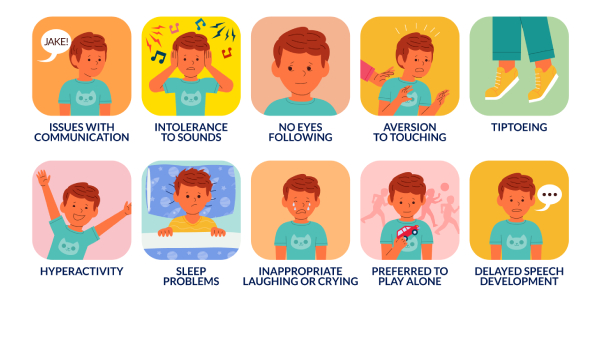April Fool’s Day for Kids: Fun and Safe Pranks for Little Jokers
Signs and Signals: How to Identify Autism Symptoms Early On

ASD causes difficulties in social interaction, and communication, and repetitive behavior patterns or extreme distress in response to changes in routines. It is very important to diagnose the signs of autism with the help of programs and services or find out the causes in the early stages for a better quality of life for the children. Parents, caregivers, and educators should learn or understand what may be considered prodromal signs and signals of autism so that they will begin to look for such in the young ones under their care and seek help if necessary. Now let us continue and unravel the most important and major symptoms.
Social Communication Challenges
This is one of the key symptoms of ASD; these children find it highly challenging to interact with their peers and even their immediate family members. Some symptoms that may differentiate infants who will in the future be diagnosed with autism include the child being unaware that he or she has been called by name, or is capable of establishing minimal eye contact. They may have difficulties when growing up, and might not understand certain signs and signals which are facial expressions, hand signs, and motions all over the body. Abnormal social communication includes difficulty in beginning or sustaining conversations, as well as restricted sharing of interests as well as feelings.
Repetitive Behaviors and Restricted Interests
Children with autism know well how to spin a toy pick at their skin repeatedly, touch objects or engage in activities that are not enjoyable to most people. These can present in various ways like handwriting disorders, persisting purposeless movements of a body part (tremors), repetitive movements (rhythmic, stereotyped) of a body part, or repeated speech or phrases. G., some are engaged in self-stimulatory behaviors (e.g., hand-flapping, rocking), are preoccupied with sameness/ routines, and have limited interest in topics/ objects. Children spend long hours with toys or apparatus, gaining deep and brilliant knowledge in limited subject matters to which they do not add themselves to other areas.
Sensory Sensitivities
On the issue of sensory sensitivities, Faulkner and Ginsberg stated that it is common in persons with ASD. He or she may be simply over- or under-responsive to sensory stimulation, which can be conscious, as in attention-deficit/hyperactivity disorder, or unconscious, as in sensory-processing disorder. Some of them include; vision, auditory, tactile, gustatory, and olfactory sensitivities. Some children may be easily frightened or jump when specific sounds are made, become uncomfortable when certain clothes are worn, or have problems tolerating crowded places or areas that are full of people.
Delayed Developmental Milestones
Delayed development can also mean the child may not be developing normally like any other child, and they may even be displaying symptoms of autism. This entails delaying the development of speech and language, motor or physical skills including crawling, walking, and Social developmental milestones, which are smiles, pointing, and even using eye contact among infants. Developmental milestones: Each child has his or her development pattern; however, if a child has intensified slowness in attaining developmental milestones or even worsens, then there is a need for a thorough assessment.
Difficulty Understanding Emotions
Some of the approaches involved with autistic people include the ability to demonstrate and comprehend emotions. One of them may relate to having problems in identifying and understanding the emotional signals that people display such as gestures or facial cues that manifest themselves in empathy and social use. To address students’ concerns about feelings, it is advisable to teach them emotional literacy and give them visuals to identify and describe emotions.
Communication Differences
In general, the specific characteristics in regards to communication in AS can vary significantly where it can begin with delays in speaking development and continue with atypical forms of speaking. Children may be slow in language development or they can display echolalia (which is the repetition of the words) or scripted speech (the emergence of replay of the lines from movies and books in English). Another issue is general dysphasia, or, more specifically, aphasia in the case of concretizing non-proper meaning that does not refer to real things.
Difficulty with Transitions and Changes
People with autism have difficulty in dealing with changes and transitions. People with autism do not like transitions or things that change when there is a routine. They exhibit aggressiveness that makes them get upset or anxious in situations where they are suddenly changed or shifted from one activity to another. The general strategies to reduce distress include setting regular schedules or providing prior notice to unrealized changes.
Lack of Imaginative Play
Play or dramatic play that is fancy or unrealistic is usually less advanced in kids with autism. They are more self-absorbed or preoccupied with objects, they may line up toys instead of pretending and playing with the toys. There are social implications to the difficulties in comprehending symbolic play as it is related to social and creativity.
Challenges with Social Relationships
For autistic persons, having and developing effective social relationships may sometimes be complicated. It can also cause them to have trouble picking up on little signs and rules of society which makes it quite difficult for them to make friends and interact with their peers. Social skills training and practice plus reciprocal opportunities for practice in structured socialization could facilitate the acquisition of social skills.
Intense Focus or Obsessions
A child with autism may line up toys, or objects, become obsessed with one particular show, or insist on constant repetition in their play. Although this is an important feature of how our brains function, this concentrated focus can sometimes hinder the shift of attention and task involvement in other related chores. Making sure that there is an equitable distribution of self-serving and other interesting experiences and developing an additional variety of experiences could go a long way in expanding their vision.
Conclusion
Early identification of autism symptoms is crucial for timely accessing interventions and support services. Parents, caregivers, and educators can contribute to vital skills building and positive outcomes among those who have autism by detecting early signs and signals of autism. To provide a comprehensive support system that caters to the unique needs of each individual, this is where families, healthcare professionals, and educators should be collaborative in their approach. As we increase our knowledge as well as understanding, it will become possible to create more inclusive environments that foster the growth of individuals with Autism.
MUST READ: Empowering Parents: Practical Tips for Raising an Autistic Child








